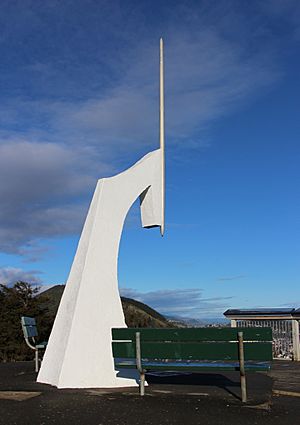Maitai, New Zealand facts for kids
Quick facts for kids
Maitai
|
|
|---|---|
|
Suburb
|
|

Marker at Centre of New Zealand
|
|
| Country | New Zealand |
| Region | Nelson |
| Ward |
|
| Electorates |
|
| Area | |
| • Total | 0.94 km2 (0.36 sq mi) |
| • Land | 0.94 km2 (0.36 sq mi) |
| • Water | 0 km2 (0 sq mi) |
| Population
(June 2023)
|
|
| • Total | 1,450 |
| • Density | 1,543/km2 (4,000/sq mi) |
| Time zone | UTC+12 (NZST) |
| • Summer (DST) | UTC+13 (NZDT) |
| Postcode |
7010
|
| Area code(s) | 03 |
Maitai is a suburb located in Nelson, New Zealand. It sits on the eastern side of Nelson's city centre, next to The Wood. The suburb is found on the northern bank of the Maitai River.
One special spot in Maitai is a monument that marks the geographic centre of New Zealand. In 2013, about 609 people lived in Maitai.
Contents
Exploring Maitai's Geography
Maitai covers a small area of 0.94 square kilometres, all of which is land. This suburb is known for its many green spaces and parks.
Parks and Reserves in Maitai
Maitai has several public areas where people can relax and play. Many of these are part of Nelson's "town belt," which is like a green border around the city. Some popular spots include:
- Botanical Gardens cricket ground
- Branford Park
- Maitai Cricket Ground
- Maitai Arboretum
- Maitai River Esplanade
- Sharland Hill Reserve
- Sir Stanley Whitehead Park
Maitai River and Trails
The Maitai River flows through the area. A winding road called Maitai Valley Road follows the northern bank of the river. This road connects Nelson to the Maitai Reservoir and Pelorus Bridge.
On the southern side of the river, you'll find Hanby Park. This park has fun walking paths and trails for BMX biking. There's also a neighbourhood located close to the park. A favourite swimming spot called Black Hole is found at a bend in the Maitai River, perfect for a cool dip.
Maitai's Population History
The number of people living in Maitai has changed over the years. In 1996, the population was estimated to be 1,480.
Here's how the population has been recorded in different census years:
- 2001: 1,410 people
- 2006: 1,332 people
- 2013: 1,314 people
- 2018: 1,362 people
As of June 2023, Maitai has an estimated population of 1,450 people.
Who Lives in Maitai?
The 2018 New Zealand census showed that 1,362 people lived in Maitai. This was a small increase from previous years. There were more females (729) than males (636) in the suburb. The average age was 46.4 years.
About 17.2% of the people were under 15 years old. The majority, nearly 50%, were between 30 and 64 years old.
Most people in Maitai (90.1%) identified as European/Pākehā. Other groups included Māori (7.3%), Asian (7.3%), and Pasifika (1.1%). About 33.7% of Maitai's residents were born outside New Zealand.
When it came to religion, 64.3% of people said they had no religion. About 24.9% were Christian. Smaller numbers followed other religions like Hindu or Buddhist.
Many adults in Maitai have a good education. About 37.2% of people aged 15 and over had a bachelor's degree or higher. The average income was $32,400.
Working and Getting Around in Maitai
Jobs in Maitai
In 2018, people living in Maitai worked in many different areas. The largest groups worked in:
- Healthcare: 14.1%
- Education: 12.1%
- Hospitality (like hotels and restaurants): 10.5%
- Construction: 7.3%
- Manufacturing: 6.0%
- Transport: 2.8%
How People Travel to Work
Many people in Maitai choose active ways to get to work. In 2018, for those who travelled to work:
- 52.8% drove a car
- 14.1% used a bike
- 14.1% walked or ran
- 2.0% rode in a car with someone else

